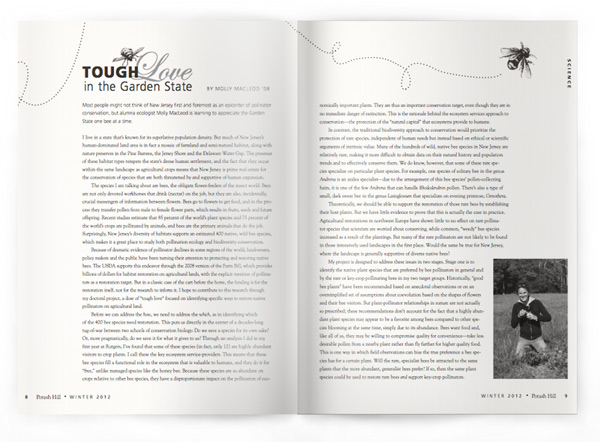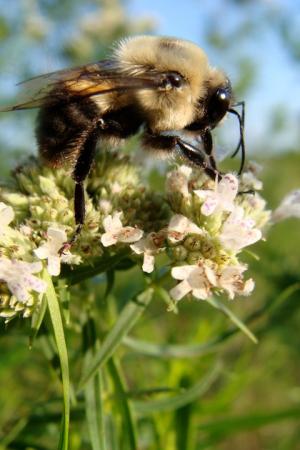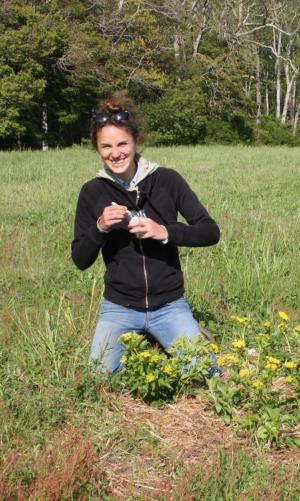Tough Love in the Garden State

By Molly MacLeod ’08
Most people might not think of New Jersey first and foremost as an epicenter of pollinator conservation, but alumna ecologist Molly MacLeod is learning to appreciate the Garden State one bee at a time.
I live in a state that’s known for its superlative population density. But much of New Jersey’s human-dominated land area is in fact a mosaic of farmland and semi-natural habitat, along with nature preserves in the Pine Barrens, the Jersey Shore and the Delaware Water Gap. The presence of these habitat types tempers the state’s dense human settlement, and the fact that they occur within the same landscape as agricultural crops means that New Jersey is prime real estate for the conservation of species that are both threatened by and supportive of human expansion.
The species I am talking about are bees, the obligate flower-feeders of the insect world. Bees are not only devoted workhorses that drink (nectar) on the job, but they are also, incidentally, crucial messengers of information between flowers. Bees go to flowers to get food, and in the process they transfer pollen from male to female flower parts, which results in fruits, seeds and future offspring. Recent studies estimate that 85 percent of the world’s plant species and 75 percent of the world’s crops are pollinated by animals, and bees are the primary animals that do the job. Surprisingly, New Jersey’s diversity of habitats supports an estimated 400 native, wild bee species, which makes it a great place to study both pollination ecology and biodiversity conservation.
Because of dramatic evidence of pollinator declines in some regions of the world, landowners, policy makers and the public have been turning their attention to protecting and restoring native bees. The USDA supports this endeavor through the 2008 version of the Farm Bill, which provides billions of dollars for habitat restoration on agricultural lands, with the explicit mention of pollinators as a restoration target. But in a classic case of the cart before the horse, the funding is for the restoration itself, not for the research to inform it. I hope to contribute to this research through my doctoral project, a dose of “tough love” focused on identifying specific ways to restore native pollinators on agricultural land.
 Before we can address the how, we need to address the which, as in identifying which of the 400 bee species need restoration. This puts us directly in the center of a decades-long tug-of-war between two schools of conservation biology: Do we save a species for its own sake? Or, more pragmatically, do we save it for what it gives to us? Through an analysis I did in my first year at Rutgers, I’ve found that some of these species (in fact, only 12) are highly abundant visitors to crop plants. I call these the key ecosystem service-providers. This means that these bee species fill a functional role in the ecosystem that is valuable to humans, and they do it for “free,” unlike managed species like the honey bee. Because these species are so abundant on crops relative to other bee species, they have a disproportionate impact on the pollination of economically important plants. They are thus an important conservation target, even though they are in no immediate danger of extinction. This is the rationale behind the ecosystem services approach to conservation—the protection of the “natural capital” that ecosystems provide to humans.
Before we can address the how, we need to address the which, as in identifying which of the 400 bee species need restoration. This puts us directly in the center of a decades-long tug-of-war between two schools of conservation biology: Do we save a species for its own sake? Or, more pragmatically, do we save it for what it gives to us? Through an analysis I did in my first year at Rutgers, I’ve found that some of these species (in fact, only 12) are highly abundant visitors to crop plants. I call these the key ecosystem service-providers. This means that these bee species fill a functional role in the ecosystem that is valuable to humans, and they do it for “free,” unlike managed species like the honey bee. Because these species are so abundant on crops relative to other bee species, they have a disproportionate impact on the pollination of economically important plants. They are thus an important conservation target, even though they are in no immediate danger of extinction. This is the rationale behind the ecosystem services approach to conservation—the protection of the “natural capital” that ecosystems provide to humans.
In contrast, the traditional biodiversity approach to conservation would prioritize the protection of rare species, independent of human needs but instead based on ethical or scientific arguments of intrinsic value. Many of the hundreds of wild, native bee species in New Jersey are relatively rare, making it more difficult to obtain data on their natural history and population trends and to effectively conserve them. We do know, however, that some of these rare species specialize on particular plant species. For example, one species of solitary bee in the genus Andrena is an azalea specialist—due to the arrangement of this bee species’ pollen-collecting hairs, it is one of the few Andrena that can handle Rhododendron pollen. There’s also a type of small, dark sweat bee in the genus Lasioglossum that specializes on evening primrose, Oenothera.
Theoretically, we should be able to support the restoration of those rare bees by establishing their host plants. But we have little evidence to prove that this is actually the case in practice. Agricultural restorations in northwest Europe have shown little to no effect on rare pollinator species that scientists are worried about conserving, while common, “weedy” bee species increased as a result of the plantings. But many of the rare pollinators are not likely to be found in those intensively used landscapes in the first place. Would the same be true for New Jersey, where the landscape is generally supportive of diverse native bees?
My project is designed to address these issues in two stages. Stage one is to identify the native plant species that are preferred by bee pollinators in general and by the rare or key-crop pollinating bees in my two target groups. Historically, “good bee plants” have been recommended based on anecdotal observations or on an oversimplified set of assumptions about coevolution based on the shapes of flowers and their bee visitors. But plant-pollinator relationships in nature are not actually so prescribed; these recommendations don’t account for the fact that a highly abundant plant species may appear to be a favorite among bees compared to other species blooming at the same time, simply due to its abundance. Bees want food and, like all of us, they may be willing to compromise quality for convenience—take less desirable pollen from a nearby plant rather than fly farther for higher quality food. This is one way in which field observations can bias the true preference a bee species has for a certain plant. Will the rare, specialist bees be attracted to the same plants that the more abundant, generalist bees prefer? If so, then the same plant species could be used to restore rare bees and support key-crop pollinators.
 To answer this question, I worked from April to September last year at a U.S. Natural Resources Conservation Service site near Cape May, New Jersey, observing an experimental bee buffet. At this site I had a field full of 26 native plant species, each planted in multiple, one-square-meter, single-species plots. The plants were chosen for this study because they were known to be generally attractive to pollinators but had not been compared with each other in a controlled setting or evaluated for their ease of cultivation. To assess the attractiveness of each plant species, I net-captured all of the flower visitors to each plot on four separate days during that plot’s peak bloom. It’s possible to identify some bees “on the wing,” but to know exactly which bees in my target groups are visiting these plants, I had to net-collect them and bring them back to the lab for identification.
To answer this question, I worked from April to September last year at a U.S. Natural Resources Conservation Service site near Cape May, New Jersey, observing an experimental bee buffet. At this site I had a field full of 26 native plant species, each planted in multiple, one-square-meter, single-species plots. The plants were chosen for this study because they were known to be generally attractive to pollinators but had not been compared with each other in a controlled setting or evaluated for their ease of cultivation. To assess the attractiveness of each plant species, I net-captured all of the flower visitors to each plot on four separate days during that plot’s peak bloom. It’s possible to identify some bees “on the wing,” but to know exactly which bees in my target groups are visiting these plants, I had to net-collect them and bring them back to the lab for identification.
Once I have all of my bees identified, I’ll rank the plants by their attractiveness based on the totals of bee abundance and diversity per species. But it wouldn’t be fair to compare a spring-blooming plant like Penstemon with a late-summer-blooming goldenrod, because the abundance and identity of bees between those times of the year are markedly different, so I’ll compare early-, mid- and late-blooming plants separately. In 2010, the first year data were collected, nine plant species were ranked as most attractive. For 2011, I’ll see whether I get the same results from more-established plants. But the real litmus test will be to see how these plants stack up next to existing restorations that were established without the bee preference data I’m collecting. This broader context will be stage two of my thesis work. Will targeted plantings using my most attractive species restore those key bee groups more effectively than previous restoration efforts? I’ll test this idea by establishing mixed-species plots in six separate sites across New Jersey. Each site will also contain an existing restoration plot and an unrestored control—an area that best represents the site’s conditions before any restoration took place. I’ll compare bee visitation to these plots over the next few years to better understand whether our current restorations are making a dent and how to better tailor them for the species that need it most.
Answering these questions would ensure that the Farm Bill funding is effective both for rare species and for species that play a key economic role in crop production. Support for insect conservation is practically nonexistent outside of this bill, due in part to a lack of biological information on most species necessary for informed, targeted conservation plans. Certainly, this lack of funding is also due to the fact that many insects are given a bad rap because of some species that are considered noxious or aggressive. Meanwhile, the tug-of-war between saving species for their own sake and saving them for more selfserving reasons makes it difficult to know where to start. Can we therefore take what little funding we have, and dovetail these divergent conservation goals? I hope so. The business of a successful restoration lies in thrifty diplomacy, and in practice it depends on a balance between well-informed risks and leaps of faith. Striking that balance is where the tough love comes in—the faith that the right connections can be made, the knowledge that they won’t just make themselves and the willingness to work for them. In the case of pollinators, we need to make that first, deliberate move.
Molly MacLeod graduated from Marlboro in 2008 with a Plan of Concentration in ecology and conservation, including a project on pollination in forest patches. She is continuing her research on pollination while pursuing a doctoral degree in ecology and evolution at Rutgers University.
Pollination Deviation
 Most of us are familiar with the idea of bees visiting flowers, but pollinators can take more unusual forms, such as lizards, rodents and primates. For her Plan of Concentration, senior Joella Simons Adkins is focusing on one group of nonconventional pollinators known as “non-flying mammals,” a.k.a. mammals other than bats. “It has been found that non-flying mammals, mainly rodents and elephant shrews, pollinate many species in the flowering plant family Proteaceae in South Africa and Australia,” said Joella. “Specialized floral traits found in South African Protea species include robust flowers situated at ground level, dull coloration, a strong yeasty odor and copious amounts of nectar that is available at night when the rodents are active.” Protea species in Australia, on the other hand, have more generalized flowers and a wider range of visitors, including birds, insects and mammals.
Most of us are familiar with the idea of bees visiting flowers, but pollinators can take more unusual forms, such as lizards, rodents and primates. For her Plan of Concentration, senior Joella Simons Adkins is focusing on one group of nonconventional pollinators known as “non-flying mammals,” a.k.a. mammals other than bats. “It has been found that non-flying mammals, mainly rodents and elephant shrews, pollinate many species in the flowering plant family Proteaceae in South Africa and Australia,” said Joella. “Specialized floral traits found in South African Protea species include robust flowers situated at ground level, dull coloration, a strong yeasty odor and copious amounts of nectar that is available at night when the rodents are active.” Protea species in Australia, on the other hand, have more generalized flowers and a wider range of visitors, including birds, insects and mammals.
